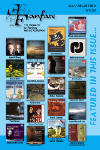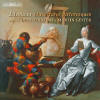Texte paru dans: / Appeared in:

Fanfare Magazine: 36:6 (07-08/2013)
Pour
s'abonner / Subscription information
Les abonnés à Fanfare Magazine ont accès aux archives du
magazine sur internet.
Subscribers to Fanfare Magazine have access to the archives of the magazine
on the net.
BIS
BIS1979

7318599919799 (ID292)
Consultez toutes les évaluations recensées pour ce cd
~~~~ Reach all the evaluations located for this CD
In an earlier review of Telemann works I lamented having long since given away a 1900 reprint of the Grove Dictionary, as I remembered very uncharitable remarks dismissing the composer. Just today I discovered that Grove edition has become available online, and to my delight, found the passage in question: “With all his undoubted ability he originated nothing, but was content to follow the tracks laid down by the old contrapuntal school of organists…He was a highly skilled contrapuntalist, and had, as might be expected from his great productiveness, a technical mastery of all the received forms of composition…but these advantages were neutralized by his lack of any earnest ideal, and by a fatal facility naturally inclined to superficiality. He was over-addicted, even for his own day, to realism…and is opposed to all depth of expression, and consequently to true art.”
What a difference a century makes! As the New Grove article on Telemann notes, 19th-century German musicologists took offense at Telemann writing numerous operas—unlike their recently crowned king, J. S. Bach—which they considered beneath the lofty status of an important Cantor. That likely accounts for the sneers about realism and true art. (And that generation of British musicians and writers on music who created Grove were mostly German-trained, or influenced.) Certainly in our own time, no baroque composer is seriously held to a yardstick measuring non-quantifiable “earnest ideals.” Nor does Telemann’s contrapuntal skill draw attention these days. What baroque composer worthy of the name lacked this? (And Wassenaer doesn’t count; he was an amateur.) Telemann is most admired in modern times for his ability to absorb and imaginatively deploy every musical style he encountered. A number of the works on the album demonstrate how well he managed this.
Telemann’s ouvertures aren’t overtures in the modern sense, but orchestral suites, derived structurally from French models. Within this very free form (basically, an overture, and any number of dances and character pieces you want to toss in), he poured a wealth of creativity. The most often heard of the group is the Ouverture in D, TWV 55:D15, and it’s the only one on this album without a program of sorts. Still, each movement is highly characterized and as distinctive in content as the Water and Royal Fireworks Music by Handel, who was a good friend of the composer.
The Völker-Ouvertüre may have gained its name in modern times, but the work lives up to it. After an overture and minuet, we get movements meant to represent dances featuring Turks, the Swiss, Moscovites, the Portuguese—then the lame, and finally, the fast. The links between nationality and music are more difficult to pinpoint, and in several instances probably reflect the composer’s humor. The startling, bell-like texture in the Moscovites’ movement, for instance, could be a sly reference to the city’s then-endless series of belled Orthodox churches.
Telemann’s whimsical humor puts in another appearance in the Ouverture, jointes d’une Suite tragi-comique from the 1760s. It presents three “illness” movements, each followed by a cure, or at any rate, treatment for symptoms. Gout? Travel by carriage, and another strengthen your legs through a gentle dance. Depression? You need distraction and merriment. Pathological vanity? Telemann provides a movement whose title was also that of a Parisian asylum, visited regularly by gawkers who paid for the privilege of watching the insane. A halting beat and chromatic descents show us the gout-ridden, while the depressive can hardly state a small part of a lengthy, nobly suffering theme (shades of Nielsen’s Four Temperaments) before it’s repeatedly interrupted by a few phrases of one quick-timed dance step after another. The vain get the three trumpets in the work’s instrumentation, much as you’d expect; and the uncontrolled, undirected energy of the inmates would probably stun anybody out of self-complacency.
The Polish Concertos are better known, and have been repeatedly recorded over the years. Telemann encountered Polish folk music while serving as Kapellmeister to Count Erdmann II of Promnitz, starting in 1705. The court summered in Pless, where rural workers performed regularly for their own pleasure, and for dances, weddings, etc. “The whimsies that these bagpipers or violinists have when they improvise, when the dancers are resting, are scarcely credible,” Telemann explained in a letter many years later. “In the fullness of time I have written various major concertos and trios in this manner, clothing then in an Italian dress…” He was hardly the only baroque composer to show a great interest in the musically bizarre. (The term “baroque” itself originally means bizarre, as when Jean-Baptiste Rousseau derided Rameau’s Dardanus in 1739 by referring to him as one of the “distiller of baroque chords of which so many idiots are enamored.”) But Telemann was of the very few who drew upon a specific regional folk music for these effects, and applied them consistently across an entire work. Drones, krakowiak rhythms, unison passages, unprepared shifts of key and melody, slow wedding dances utilizing tetrachord-based scales: These and more are placed within a surrounding Italianate texture to excellent effect.
Don’t let the name fool you: Arte dei Suonatori is a Polish period-instrument ensemble formed in 1993. They’ve been favorably reviewed in the past in these pages. James Reel referred to their performances of the opus 6 concerti grossi by Handel as “wonderfully polished” (32:4), and their version of Vivaldi’s La stravaganza as “a tour de force of technique and interpretation” (27:2). I would agree with all this, and add that their strong feel for rhythm, color, and subtle phrasing is especially noticeable. Only once did I feel they went on a wrong tack, in the quicksilver Harlequinade movement to the Ouverture in D, TWV 55:D15, which was taken far too slowly. Otherwise, they offer up great energy and character.
With excellent, crisp, and well-balanced sound, this one’s a winner.
Cliquez l'un ou l'autre
bouton pour découvrir bien d'autres critiques de CD
Click either button for many other reviews


